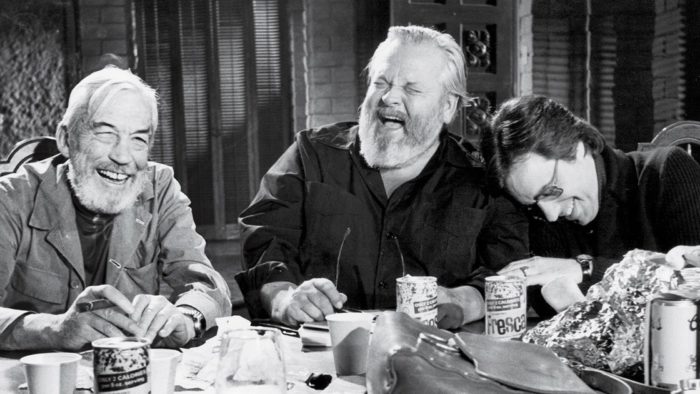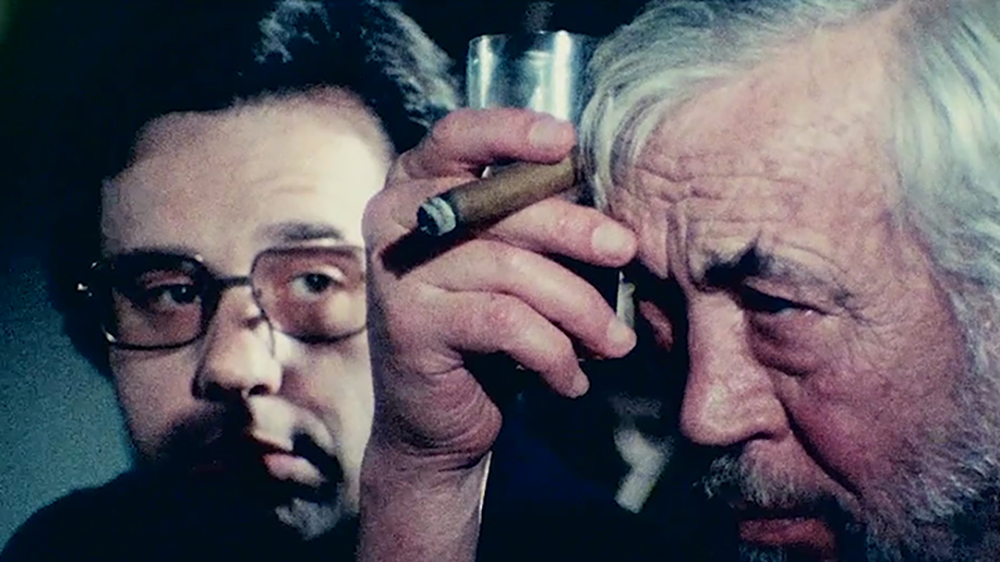It’s been fascinating to me to learn more about and to finally see Orson Welles’ final film The Other Side of the Wind (Netflix, 2018).
A biting satire of Hollywood and sort of a film-within-a-film itself, The Other Side of the Wind is about a legendary film director named Jake Hannaford (played by the real-life legendary director John Huston) who is attempting to resuscitate his languishing career by making an avant-guard film called, well, The Other Side of The Wind. Hannaford needs an influx of cash to finish the project, so he throws a screening party at an expansive home in Arizona and invites potential investors and various members of the Hollywood media to show them parts of the unfinished film.
Orson Welles began shooting the film in 1970. Filming continued sporadically for six more years. From what I’ve read, it sounds like a combination of Welles’ temperament along with a series of complicated financial deals brought the work on the film to a standstill. Welles died in 1985 and the film remained in an unfinished state and became a “holy grail” of sorts for devotees of Welles’ work.
Multiple attempts have been made over the years to complete the film. Finally, the deep pockets of Netflix along with the work of director Peter Bogdanovich (who also stars in the film) and movie producer Frank Marshall (who was an assistant on the film) were able to get the job done.
While Welles supervised some of the editing himself when he was actively working on the film, what we have for our viewing pleasure now is an attempt by multiple filmmakers, artists, and technical experts to recreate a work by a notoriously fickle auteur. Writer and self-professed Orson Welles “obsessive” Alex Ross in a very interesting article in The New Yorker wrote:
“Welles buffs will long argue over their choices, but the film is a major addition to the director’s canon, offering a sometimes harrowingly personal vision. Hannaford is hardly a self-portrait, but his predicament is not unlike Welles’s own: he is a legend whose past overshadows his present. At the same time, ‘Wind’ is an exhilarating forward leap, its rapid-fire editing and pseudo-documentary format heralding modern styles. Ultimately, it has the Wellesian quality of not caring what you make of it. As one of Hannaford’s minions says, bringing out a stack of film cans, ‘Well, here it is, if anybody wants to see it.'”
Ross also details in his excellent piece about the physical and technical challenges of assembling the film. “[Sound supervisor Daniel] Saxlid, a wizardly Swede, spent more than three months cleaning up the dialogue, working seven days a week in a windowless room in Technicolor’s post-production facility on the Paramount lot. Multiple transfers of the soundtrack had caused a build-up of noise and distortion…Saxlid developed a…program, “a kind of forensics,” to expand microscopic portions of the track and reduce noise while preserving the voices. All this solitary activity gave him a curious sense of interaction with Welles himself. ‘So much of this we couldn’t have done even a few years ago. All these endless delays drove everyone crazy, but maybe the thing had to wait until we had all the right tools for it. I kept having a funny feeling that Welles had tossed all this to the future, for us to figure out.'”
They definitely figured things out technically. The film is fascinating to watch—almost as if Welles had come back from the grave to give us one last film. The imagery is sometimes a bit challenging and unplesant, but is also sometimes absolutely revelatory in its composition, style, and technical excellence. I wonder if we’ll ever figure out all of what Welles was trying to say. To me, it was like Welles taking his hands off the steering wheel of a speeding car, giving the middle finger to Hollywood, but then crashing and, sadly, losing his life in a rather self-consumed and futile way.

The film is currently available on Netflix. Also of interest is a behind-the-scenes documentary about the creation of the final cut called They’ll Love Me When I’m Dead, which is currently on Netflix as well.
The Other Side of the Wind is rated R by the Motion Picture Association of America for “sexual content, graphic nudity and some language.”
My score: 4 out of 5 stars
Images ©️ Netflix

